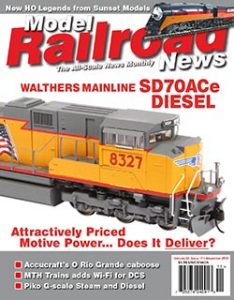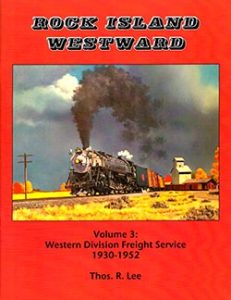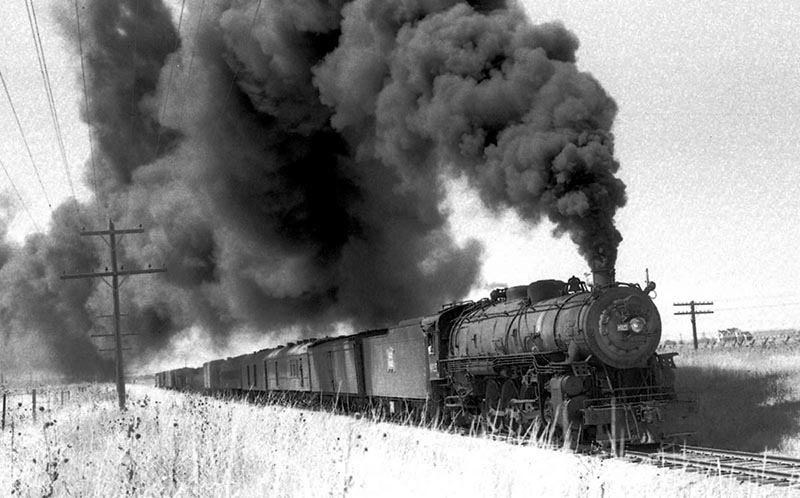 Review by Tony Cook/photos as noted
Review by Tony Cook/photos as noted
The most recent volume in author Thomas R. Lee’s series on Rock Island was 1998’s Rock Island Westward, Volume 2 Rails to the Rockies: A History of the Western Division. The series debuted with the 1992 release of Rock Island Westward, Volume 1 Memories of the High Line: A History of the Clay Center Line. The first title covered its section of Rock Island’s system from the railroad’s start in the 1880s through its demise and subsequent shutdown in 1980. Lee’s second book focused on passenger operations for Rock Island’s west end. A third volume was underway when Thomas Lee passed in 2014. South Platte Press, working with Lee’s family, now brings the third volume to print for the railroad historian to enjoy.
Rock Island Westward, Volume 3: Western Division Freight Service 1930– 1952 is a 40-page softcover title. Readers owning or familiar with the first two volumes in this series will recall those efforts were hardcover books consisting of more than 250 pages each. Both of those earlier efforts are out of print at present. Model Railroad News suggests checking with railroad booksellers such as Ron’s Books and others in searching for copies of Lee’s first two Rock Island Westward titles. This third truncated volume is made up of Thomas Lee’s work-in-progress efforts. South Platte Press’ Jim Residorff worked to bring together a publication from Lee’s files. Publisher Residorff notes that Lee had not begun final photo selections, nor had he written captions for images under consideration for the book. South Platte supplied photos from Otto Perry’s collection and others to illustrate this volume. The more than 30 vintage black & white Rock Island views — mostly steam era since the book’s focus concludes in 1952 — are appropriate to the story and work well for this modestly priced title.
 Though the book’s period of focus means steam locomotives are the standard motive power, you will find some early diesels on display in Rock Island Westward, Vol. 3. Otto Perry documented a Rock Island BL2 leading a mixed train in eastern Colorado in the summer of 1951. South Platte Press used photographer Perry’s classic rail images to illustrate its new book. Photo by Otto Perry
Though the book’s period of focus means steam locomotives are the standard motive power, you will find some early diesels on display in Rock Island Westward, Vol. 3. Otto Perry documented a Rock Island BL2 leading a mixed train in eastern Colorado in the summer of 1951. South Platte Press used photographer Perry’s classic rail images to illustrate its new book. Photo by Otto Perry
After discussing the building and development of Rock Island’s western end in his first book, Lee focused on passenger operations for his second effort. Rock Island freight handling on this segment of the line remained to be told. Freight ran on this part of Rock Island’s rails from 1886 to 1980. For its new book, South Platte Press takes Lee’s work detailing freight operations from 1930-1952. Lee’s introduction is accompanied by Jim Reisdorff ’s explanation of how the publisher determined what was ready for use from the original author’s unfinished work.
This is a “must-have” library addition for anyone interested in the Rock Island and especially so for those who own the first two Rock Island Westward titles. This book serves as a good resource for Rock Island modelers for understanding freight operations on this part of the fallen flag’s system during the time frame covered. Terminating officially in Colorado Springs, Colo., Rock Island was practicing its unfortunate plan of “everywhere worst” by skipping Denver. The road managed this same feat by avoiding Kansas City originally too. To the credit of the road’s planners, the Colorado Springs terminus made sense at the time since Rock Island would have a connection with Colorado Midland — the only standard gauge railroad back then, building directly west into the Rockies. Similar to how Kansas City developed into the more important commerce center despite Rock Island’s original efforts to include St. Joseph, Mo., Denver proved to be the transportation hub that Colorado Springs was not. Rock Island’s answer to that misstep was to gain access from Limon, Colo., northwest to Denver via Union Pacific’s Kansas Pacific track.
 One of Rock Island’s more than 100 EMD GP7s, new in the early 1950s, is at Limon, Colo., coupled to a P-33 class 4-6-2 nearing its retirement. This Otto Perry scene was captured in November of 1951. Photo by Otto Perry
One of Rock Island’s more than 100 EMD GP7s, new in the early 1950s, is at Limon, Colo., coupled to a P-33 class 4-6-2 nearing its retirement. This Otto Perry scene was captured in November of 1951. Photo by Otto Perry
Footnotes provide commentary and additional information with each chapter to help fill in where Lee’s narrative is incomplete. The book wraps up with postwar changes and takes the reader into the early 1950s. Reference in the opening of this book suggests Lee’s notes on Rock Island freight from 1952 to 1980 may exist, and readers can hope for another similar book perhaps to arrive in the future, bringing this part of Rock Island’s story through to the road’s end. This is a well-executed, though brief, attempt at adding to a popular series of rail history books. You often hear of an author being in the process of working on a book that doesn’t make it to print. This South Platte Press third volume for Rock Island Westward gives the rail historian an important addition to this series.
 Rock Island Westward, Volume 3:
Rock Island Westward, Volume 3:
Western Division Freight Service: 1930-1952
by Thomas R. Lee
MSRP: $19.95
South Platte Press
P.O. Box 163
David City, NE 68632-0163
(402) 367-3554



